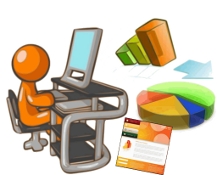For obtaining, querying, analyzing and reporting value information, final users have special tools that access data warehouses and data marts (even Operational Data Stores), and these tools access the data dictionaries for document and inform to users what is the accessed data and which is its meaning.

The Results are shown...
From final users’ point of view, Business Intelligence Tools could be classified among three types of functions:
- Presentation tools: Business Intelligence Portals, Dashboards and regular preconfigured reports belong to this category. These tools are user-passive actions because the user request or call the result of these tools with no other interaction.
- Querying Tools: Any tool with some grade of user interaction could belong to this category. Starting from parameterized presentation tools, other tools could be OLAP querying applications, smart querying tools and users-friendly reporting applications.
- Analysis Tools: In order to determine hidden tendencies or behaviors or digging deeply on information insights, the users could utilize data mining tools, what-if applications and advanced-statistical software.
Depending on which kind of data (operational, summarized/resumed), the type of access (consult/querying, analysis/data mining/what-if) and function level (executive, data-cruncher, operational) every user could require a combination of tools to achieve their Business Intelligence functions and goals.